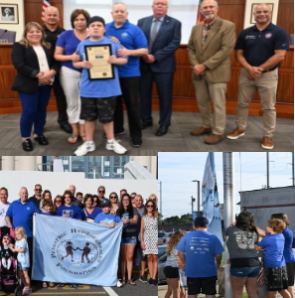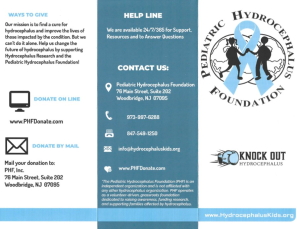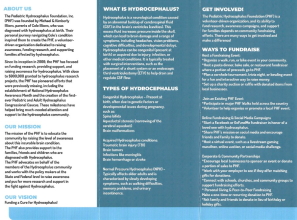6-Year-Old Elyse Clough From New York Selected as 2016 National Ambassador of Hydrocephalus Awareness for Incurable Brain Condition
February 3, 2016 by PHF
Filed under Uncategorized
Comments Off on 6-Year-Old Elyse Clough From New York Selected as 2016 National Ambassador of Hydrocephalus Awareness for Incurable Brain Condition
6-Year-Old Elyse Clough From New York Selected as 2016 National Ambassador of Hydrocephalus Awareness for Incurable Brain Condition
 Elyse was born on May 26, 2009, 3 ½ months premature, weighing just over a pound. While in the NICU, she had a major brain bleed, which caused her to have fluid accumulation in her brain. After two spinal taps while she was in the hospital, we thought the issue with the excess fluid was resolved.
Elyse was born on May 26, 2009, 3 ½ months premature, weighing just over a pound. While in the NICU, she had a major brain bleed, which caused her to have fluid accumulation in her brain. After two spinal taps while she was in the hospital, we thought the issue with the excess fluid was resolved.
On October 12, 2009, just one month after being discharged from the hospital after birth, Elyse presented with symptoms that we now associate with hydrocephalus. She woke up extremely fussy, vomiting profusely, and when she opened her eyes, only white could be seen. We took her to the pediatrician, who immediately recognized this as hydrocephalus.
We rushed her to the hospital where she had emergency brain surgery to insert her first shunt. This was a terrifying experience. We were unfamiliar with a shunt and with hydrocephalus, and the situation was extremely overwhelming. About three weeks later, we brought Elyse back to the hospital fearing her shunt had failed, since we now recognized the symptoms.
The standard tests that are performed showed no abnormalities, and despite our pleas and efforts, she was released to go home. Later that same week, we rushed her back to the hospital where they determined her shunt had indeed failed. This second shunt failed in June of 2010. After this, Dr. Satish Krishnamurthy, Elyse’s neurosurgeon, along with a group of patients and families struggling with hydrocephalus realized the need for a cure and a support group for hydrocephalus.
That September, REaCH Organization was created. REaCH stands for Research, Educate, and Cure Hydrocephalus. On December 28, 2014, Elyse woke from a nap having a seizure. Again, we rushed her to the hospital, to find that her shunt had failed again. This fourth shunt only lasted until September 5, 2015.
She presented again with a seizure due to the increased pressure in her brain from the excess of spinal fluid. Again, the shunt failed. This shunt revision has been the worst experience for Elyse so far. She unfortunately suffered another brain bleed while the catheter of the shunt was removed, and her recovery has been much slower than before.
It has been very difficult for the entire family. During this recovery, we had a benefit in honor of Elyse to raise money for hydrocephalus research. With the help of many people and businesses, we were able to raise over $10,000 that was given to the Upstate University Hydrocephalus Research Fund.
This money will go directly to Dr. Krishnamurthy’s research to find a better solution and quality of life for those people who suffer with hydrocephalus.
11-Year-Old Tyler Side From Washington State Selected as 2016 National Ambassador of Hydrocephalus Awareness for Incurable Brain Condition
January 31, 2016 by PHF
Filed under Uncategorized
Comments Off on 11-Year-Old Tyler Side From Washington State Selected as 2016 National Ambassador of Hydrocephalus Awareness for Incurable Brain Condition
11-Year-Old Tyler Side From Washington State Selected as 2016
National Ambassador of Hydrocephalus Awareness for Incurable Brain Condition
Up until the night Tyler was born, my pregnancy had gone perfectly and we didn’t have any reason to suspect that the remaining 11.5 weeks would be any different that the first 28.5 weeks had been. At the time, my husband and I were stationed at Ramstein Air Force Base in Germany, away from family and friends, but embracing the culture and travel that being stationed overseas offered. After a day at work and suddenly becoming ill, I agreed to go to the hospital thinking that I would just need fluids to combat what I thought might be the flu. Little did I know that night would change our family’s lives and prove to be one of the most emotional rides we’ve ever been on.
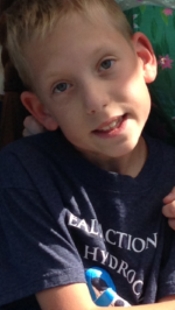 Tyler was born at 28.5 weeks gestation on January 28, 2005 in Landstuhl, Germany due to placental abruption resulting in an unplanned emergency C-section. At 2 pounds 12 ounces, he was rushed to the NICU to be ventilated and for many days his survival was not certain. Early ultrasounds showed that Tyler had a Grade 2 and Grade 4 intraventricular hemorrhage and we were devastated when the doctor told us that any further evidence of bleeding in his brain would mean that there was nothing else they could do for him. In the days that followed, we were hopeful that Tyler would pull through but uncertain what that would eventually mean.
Tyler was born at 28.5 weeks gestation on January 28, 2005 in Landstuhl, Germany due to placental abruption resulting in an unplanned emergency C-section. At 2 pounds 12 ounces, he was rushed to the NICU to be ventilated and for many days his survival was not certain. Early ultrasounds showed that Tyler had a Grade 2 and Grade 4 intraventricular hemorrhage and we were devastated when the doctor told us that any further evidence of bleeding in his brain would mean that there was nothing else they could do for him. In the days that followed, we were hopeful that Tyler would pull through but uncertain what that would eventually mean.
When there were no additional signs of increased bleeding in his brain, we celebrated but were told that due to the damage, Tyler may never walk or talk, and though the bleeding had stopped, he was not nearly out of the woods. A few days later, at twenty days old, we received news that Tyler had post-hemorrhagic hydrocephalus and at the time had no idea what this meant or how it would affect our precious baby. Since we were still at the military hospital in Germany, we didn’t have access to a pediatric neurosurgeon and were faced with a choice to be transferred to an off-base German hospital or sent back to Bethesda Maryland where he could be treated. We chose the latter and with short notice were moving across the world on a military medical evacuation flight to the National Naval Medical Center. To say that Tyler’s first month of his life was a whirlwind would be an understatement, but we would soon find that the ups and downs had only just begun.
Arriving in Maryland, we were thankful to be stateside, but were still far from our family in Washington State (though we did have quite a few visitors to see our miracle baby!) Tyler’s first shunt was placed externally and it pained us to continue to see him connected to so many tubes, though it did help relieve the pressure which had caused him so much discomfort. Unfortunately, that surgery would be the first of many as Tyler ended up needing a second, third, fourth and fifth external shunt all within 10 weeks. We struggled knowing that the surgeries were necessary but knew that every time the doctors would have to operate, the risk of the shunt failing continued to increase as the white blood cells rushed to heal the site where it could easily clog the catheters meant to help him.
Our next obstacle came when Tyler was diagnosed with necrotizing enterocolitis, and he had to have a large section of his bowel removed. This was another setback in his healing, and we were again filled with questions, worry, and doubt. We often felt so unprepared and spent countless hours and days in the NICU sitting beside Tyler’s bed just hoping and praying that the progress he made each day would not continue to be set back by surgery, infection, and uncertainty.
At just over 3 months in the Bethesda, we were again transferred to another hospital, this time moving to the Children’s Hospital of Philadelphia where Tyler’s shunt would be internalized. While this seemed to be a promising next step, it took a couple tries as the first shunt, a ventricular peritoneal shunt failed due to the scar tissue from the bowel resection. Much to our dismay, the next location that was chosen for Tyler’s shunt placement was through his jugular vein and into his heart, a ventricular atrial shunt.
Nothing seemed scarier, at the time, then knowing that the surgeons were going to feed the catheter through Tyler’s jugular vein toward his heart and have his body absorb the fluid in his bloodstream! Especially in such a tiny body, it seemed impossible that this option would work. However, on May 24, 2005, after nearly 4 months in the NICU, Tyler was finally able to come home!! He had undergone seven shunt surgeries and one bowel resection, but we were elated to finally be leaving the hospital. Being first time parents, we were paranoid about who he was around, if people had washed their hands before holding him, and where he may be exposed to germs, and having him just come home from the hospital after a roller coaster ride his first four months, we were even more paranoid! While the shunt did work for a short time, we did end up in the hospital four more times for shunt revisions in 2005.
Thankfully, however, in 2006, 2007, and 2008, Tyler only needed one revision each year, the last of which was to change the location of his shunt to be a ventricular pleural shunt. During his 2008 surgery, I can clearly remember the pediatric neurosurgeon coming to speak with us after the surgery with a concerned look. The surgery had taken much longer than normal, and the neurosurgeon had described the new location as having to ‘get creative’ in deciding where to go since the many revisions he already had used the most common shunt locations. Thankfully, the new placement was a success and since September 2008, Tyler has only had to have two more revisions, the most recent of which was in July 2014. To date, Tyler’s hydrocephalus has resulted in 16 surgeries so far, and like most parents of a child with hydrocephalus, the next possible shunt failure and surgery is always in the back of your mind.
Anyone that has met Tyler will say he is the sweetest and most charming boy. And any early doubts about his ability to walk or talk were proved wrong as Tyler worked through speech, occupational, and physical therapy to meet major milestones. The resilience and strength Tyler has shown in light of all that he has been through has taught us so much about life and perseverance. At ten (nearly eleven he reminds me), Tyler says he wants to be a doctor when he grows up and he loves riding his bike and scooter, skateboarding, playing video games with his friends, and listening to music.
When I asked him how he feels about having hydrocephalus, he said that sometimes he’s scared and sometimes he is just sad. He’s scared because he doesn’t know when his shunt is going to stop working and it makes him sad that he can’t play soccer like some of the other kids since he can’t get hit in the head. He said, “Being a kid with hydrocephalus is scary because the doctors have to cut into your head to find out what is wrong with your shunt.” But he followed this by saying, “but once, they’re done, then you feel much better.”
We are forever thankful to all of our family, friends, teachers, and medical staff who continue to show such support for Tyler and all he has been through. We are hopeful that with continued research we can improve the technology being used to treat this condition and eventually find a cure!
2016: National Ambassadors of Hydrocephalus Awareness
December 13, 2015 by PHF
Filed under Uncategorized
Comments Off on 2016: National Ambassadors of Hydrocephalus Awareness

We are looking for one male and one female to serve as our National Ambassadors for Hydrocephalus Awareness for our 2016 National Hydrocephalus Awareness Campaign, with marketing and promotional materials all through the year ending September 2016 with National Hydrocephalus Awareness Month.
We will randomly select ONE male and female from all entries received. Submit a picture of your nominee, between the ages of newborn to 19 years old, with their name and D.O.B. (These pictures MUST BE E-MAILED to mike@hydrocephaluskids.org- Facebook entries are not valid)
The 2 winners will be awarded a 2 NIGHT STAY @ the Crystal City Embassy Suites in Washington DC during our 6th Annual PHF Day of Hydrocephalus Awareness on Capitol Hill Event on 8/18 & 8/19 in 2015, (travel not included).
To enter, email a picture of your nominee, (between the ages of newborn to 19 years old), with their name, D.O.B. & current city & state)
Contest ends 12/31/2015 & Winners announced on 1/2/2016
* Email your picture to mike@hydrocephaluskids.org
* Previous winners are not eligible.
* PHF Board Members & State Chapter Directors ARE eligible to participate.
* By submitting a photo, you agree that the picture may be used in promoting this contest, promotional materials for the PHF, and other PHF outreach campaigns.
Check out the picture galleries of everyone nominated:
The Girls
Edison family hosts dinner to benefit Hydrocephalus research
November 21, 2015 by PHF
Filed under Uncategorized
Comments Off on Edison family hosts dinner to benefit Hydrocephalus research
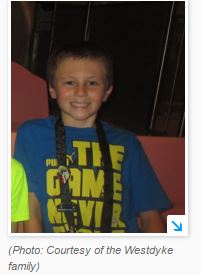 Jennifer Westdyke of Edison found out her son Jeffrey likely had hydrocephalus when she was 20 weeks pregnant. Her son, now 9, has battled the disease since birth, undergoing his first brain surgery when he was 3 years old and another two since then.
Jennifer Westdyke of Edison found out her son Jeffrey likely had hydrocephalus when she was 20 weeks pregnant. Her son, now 9, has battled the disease since birth, undergoing his first brain surgery when he was 3 years old and another two since then.
To raise awareness about this incurable brain condition, the Westdyke family is hosting a Funding a Cure for Hydrocephalus Pasta Dinner with the Pediatric Hydrocephalus Foundation on Sunday, Nov. 22, from 2 to 6 p.m. at the Edison Elks 2487 at 375 Old Post Road in Edison.
Hydrocephalus is a condition in which the primary characteristic is excessive accumulation of fluid in the brain, according to the National Institute of Neurological Disorders and Stroke. Some people think of hydrocephalus as “water on the brain;” however it is actually cerebrospinal fluid — a clear fluid that surrounds the brain and spinal cord, according to the institute.
Hydrocephalus can be acquired or congenital. The congenital form is present at birth and may be caused by either genetics or events that occurred during fetal development. Acquired hydrocephalus can develop at the time of birth or at some other point after because of injury or disease.
“There hasn’t been any new technology in a long time,” said Westdyke. “They are still using the same shunt technology from the 1950s.”
She said compared to others with the disease, her son has been fortunate; he is highly functioning, attends regular classes in school and hadn’t had many surgeries. “My son is not the norm. There are many children who have had 30 or 40 surgeries and have had many other problems as a result,” she said.
Hydrocephalus is generally treated by surgically inserting a shunt system that diverts the flow of cerebrospinal fluid to another area of the body where it can be absorbed as part of the normal circulatory process.
The family’s goal with the pasta dinner is to raise awareness about the disease and money to help research.
“Hydrocephalus is an incurable brain condition that affects one in ever 500 newborns, and over a million Americans,” she said. “Adults affected include veterans coming home and football players with head injuries.”
The pasta dinner will feature homemade food, entertainment and more.
“My mom and I rolled 500 meatballs, and my friend makes a great salad that everyone comes back for more,” along with homemade desserts, she said. “We have a DJ, face painting, basket raffles, a 50-50 and vendors, who donate profits. It should be a very fun evening.”
There will be a special appearance by MJX & The 2 Bad Crew Special Needs Dance Class.
It’s all you can eat, and tickets are $10 per adult and $5 per child (4 and younger are no charge).
The Pediatric Hydrocephalus Foundation was founded in New Jersey in 2009 by four families, each having a child with this incurable brain condition, said Michael Illions, the organization’s vice president and director of advocacy. The non-profit charitable organization’s goal is to raise awareness about hydrocephalus and provide support to families, friends and children affected by the condition.
“This is our fifth dinner to raise money,” he said. “We have been very successful in the past, drawing professional wrestlers doing autograph signings, dignitaries, even members of congress. The money is used for research. All of the money goes to that, as we are an all volunteer organization with no salaries.”
The Woodbridge resident’s son, Cole, was born with hydrocephalus, and he and his wife are among the organization’s founders.
“We are hoping to raise $5,000,” Illions added. “It’s just one of the many events we do.”
Other events include the annual New Jersey Walk & Family Fun Day for Hydrocephalus Awareness, which took place in September. This year’s drew 350 people and raised more than $27,000 to fund research projects for better treatment options and to find a cure.
“We donate to hospitals all across the country,” Illions said of how the funds raises are disbursed. “They send us research grant applications, and we evaluate each one.”
His son, at the age of 10, already has had 13 surgeries.
“It really ranges how much children are affected,” he added. “Not every child is the same. There is the possibility of global developmental delays. Some are more affected than others. My son is completely nonverbal.”
Oftentimes, too, problems occur with the shunt, and it has to be fixed or redone. Sometimes surgeries can result in development delays or other complications.
Westdyke said her son didn’t often talk about how having hydrocephalus had affected him. But earlier this year he did, when the the family traveled to Washington, D.C., to talk to staffers, congressman and senators about the disease.
“He said, ‘I’m scared that when I go to sleep at night, I won’t wake up in the morning.’” She added, “He gets it. I couldn’t stop crying when I heard that.”
For more information, visit www.hydrocephaluskids.org/wordpress/.
Tickets for the Nov. 22 dinner are available online at http://www.active.com/donate/phfpasta.
September 30th: “One Day….. One Donation”: PHF Hydrocephalus Awareness Money Bomb!
September 29, 2015 by PHF
Filed under Uncategorized
Comments Off on September 30th: “One Day….. One Donation”: PHF Hydrocephalus Awareness Money Bomb!
PHF September 30th Hydrocephalus Awareness Money Bomb
“One Day….. One Donation”
MAKE YOUR DONATION TODAY!
Click to Enter the Hydrocephalus Awareness MONEY BOMB Donation Website!
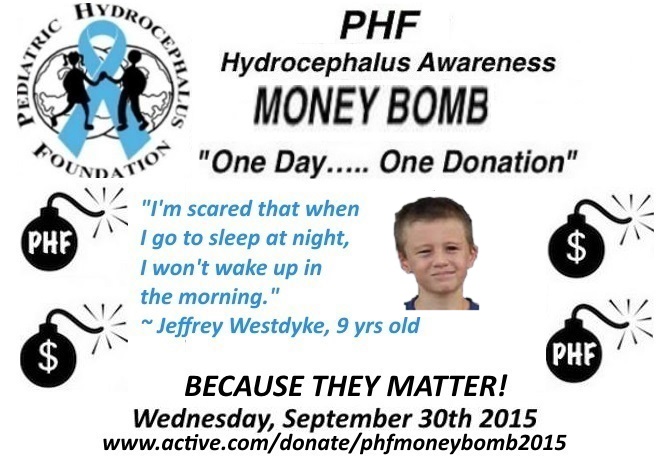
PHF September 30th Hydrocephalus Awareness MONEY BOMB!!!
“ONE DAY….. ONE DONATION”
The Pediatric Hydrocephalus Foundation (PHF), the nation’s #1 advocate for children with Hydrocephalus, needs your help Today for our 3rd Annual Hydrocephalus Awareness MONEY BOMB to raise funds for our amazing initiatives & Hydrocephalus research project funding rolling out in 2015 and beyond!
Last year’s Money Bomb! was a huge success, raising just under $5,000.00 in 24 hours!!
The PHF is dedicated to raising the level of awareness of this incurable brain condition, providing support to those who are diagnosed with Hydrocephalus, and most of all raising money to help fund a cure and better treatment options for our loved ones fighting this battle!
In 2009 the month of September has been named “National Hydrocephalus Awareness Month” and this year has been OUTSTANDING! The outpouring of support the PHF has received from around the country has been INCREDIBLE!
But we need your help TODAY to make it our best month ever for fundraising.
So we’re asking everyone to participate again, in the 3rd Annual Hydrocephalus Awareness MONEY BOMB TODAY so we can end this year’s Hydrocephalus Awareness Month with a bang, and keep the momentum going for the next few months and into 2016!
If every supporter of the PHF who believes in our mission and wants to support the outstanding success we have had as advocates for children and families affected by Hydrocephalus contributes TODAY, we’ll have a record-breaking fundraising success.
We are counting on you to contribute and push the PHF to new heights!!! Click below, and thank you for your generosity!!!
Join us for this special On-Line Fundraising event- PHF’s Hydrocephalus Awareness MONEY BOMB!
“ONE DAY….. ONE DONATION”
As your making your donation, don’t forget to use the “comment” field to give a shout out to your Hydro Hero!
The Pediatric Hydrocephalus Foundation is a non-profit 501 (c) (3) non-profit charitable organization. All donations are tax-deductible.
Click to Enter the Hydrocephalus Awareness MONEY BOMB Donation Website!
 Read more at: https://html.com/attributes/img-width/>
Read more at: https://html.com/attributes/img-width/>











